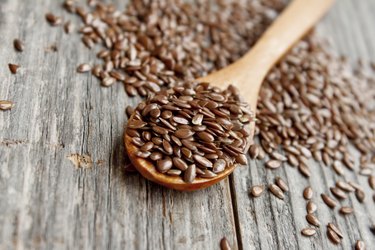
Chia seed, hemp seed, sesame seed, flaxseed, linseed — it's hard to keep them all straight. One thing you can be sure of is that eating more of them can benefit your health. When it comes to linseed vs. flaxseed — and their meals — there's little confusion because they are the same thing.
Tip
Flaxseed and linseed meal are the same thing, but flaxseed is most often used to refer to the human food source.
Video of the Day
Linseed vs. Flaxseed Meal
Linseed and flaxseed come from the same plant, Latin name Linum usitatissimum, which means "very useful." Indeed it is. Cultivated as a crop since the beginning of human civilization, it was first used in the U.S. by colonists to produce clothing. It is also used as animal feed, to make paper and as a furniture polish.
Video of the Day
In the 1990s, researchers began to investigate the seeds' biologically active components and their potential effects on human health, and flax eventually became an important human food, referred to as a functional foo_d_. These healthful components chiefly include dietary fiber and omega-3 fatty acids.
The major difference between flaxseed and linseed is simply a matter of purpose. When consumed as a food, it is called flaxseed; when used for other purposes, it is typically referred to as linseed, according to a September 2014 article in the Journal of Food Science and Technology. Linseed meal may be used in feed for livestock or to make fabric or paper, but flaxseed meal is the type you will find on grocery store shelves — or that you can make at home by finely grinding the seeds.
Flaxseed Fiber Facts
Flaxseeds contain all three macronutrients — protein, fiber and fat — and in significant amounts. One tablespoon has nearly 2 grams of fiber, per USDA data. That amount is 8 percent of the recommended dietary intake (RDI) for women and 5 percent of the RDI for men, according to the Dietary Guidelines for Americans.
Dietary fiber accounts for a minimal amount of the calories in flaxseed, but it makes a crucial contribution to digestive and heart health.
Fiber is primarily found in the seed's outer covering. The tough, chewy hull isn't well digested by the body; therefore, it remains relatively unchanged, adding bulk to waste and helping it move more easily through the digestive tract to be excreted. This normalizes bowel movements and maintains colon health, protecting against maladies such as diverticular disease and colon cancer.
Flaxseeds are a particularly rich source of one type of fiber called soluble fiber. As its name implies, soluble fiber changes when it comes in contact with fluids in the stomach, turning into a gel-like substance. It isn't absorbed by the body and doesn't provide nutrients, but it does attract unhealthy cholesterol and carry it out of the body.
High-fiber diets are associated with decreased cholesterol and improved cardiovascular health, according to a study in the International Journal of Environmental Research and Public Health in May 2015.
Read more: 19 High-Fiber Foods — Some May Surprise You!
Plant-Based Healthy Fats
Flaxseeds can also contribute to a healthy heart and brain by providing omega-3 fatty acids. This type of polyunsaturated fat can actually help improve your cholesterol profile, by increasing levels of healthy high-density lipoproteins (HDL) that help remove bad cholesterols from your body. Higher HDL blood levels are associated with reduced risk of heart disease.
Omega-3s also have anti-inflammatory effects that contribute to improved heart health by preventing hardening of the arteries, or atherosclerosis. Further, they have neuroprotective effects. A wealth of research has examined omega-3s' role in neurodegenerative diseases such as Alzheimer's.
According to a review in BioMed Research International in February 2015, there is promising evidence in humans that omega-3s can prevent or slow the cognitive decline in the early stages of Alzheimer's, but more research is needed.
The best sources of omega-3s are fish and other seafood; however, plant-based vegetarian and vegan diets must rely on alternative sources, such as flaxseed. The concern is that the omega-3s in plant foods aren't as easily absorbed as the fatty acids in marine foods.
Fish and other animal foods contain two types of omega-3s — eicosapentaenoic acid (EPA) and docosahexaenoic acid (DHA). Flaxseeds and other plant foods contain a third type of omega-3 called alpha-linoleic acid (ALA). The body can use EPA and DHA as is, but it must convert ALA into EPA and DHA. However, only 10 to 15 percent of ALA becomes EPA and DHA, and the rest is burned as energy, according to Harvard Health Publishing.
While flaxseeds can contribute to adults' daily DHA and EPA needs, people who follow plant-based diets may need additional sources. According to an article in Marine Drugs in January 2018, microalgae are a significant plant-based source of EPA and DHA.
- Marine Drugs: "Marine Cryptophytes Are Great Sources of EPA and DHA"
- Harvard Health Publishing: "Why Not Flaxseed Oil?"
- BioMed International: "Omega-3 Fatty Acids in Early Prevention of Inflammatory Neurodegenerative Disease: A Focus on Alzheimer’s Disease"
- Journal of Food Science and Technology: "Flax and Flaxseed Oil: An Ancient Medicine & Modern Functional Food"
- USDA FoodData Central: "Seeds, Flaxseed"
- International Journal of Environmental Research: "Beneficial Effect of Higher Dietary Fiber Intake on Plasma HDL-C and TC/HDL-C Ratio Among Chinese Rural-to-Urban Migrant Workers"
- Mayo Clinic: "Dietary Fiber: Essential for a Healthy Diet"
- Cleveland Clinic: "Omega-3 Fatty Acids"
- Mayo Clinic: "HDL Cholesterol: How to Boost Your 'Good' Cholesterol"
- Health.gov: "Dietary Guidelines for Americans, 2015-2020: Appendix 7. Nutritional Goals for Age-Sex Groups Based on Dietary Reference Intakes and Dietary Guidelines Recommendations"